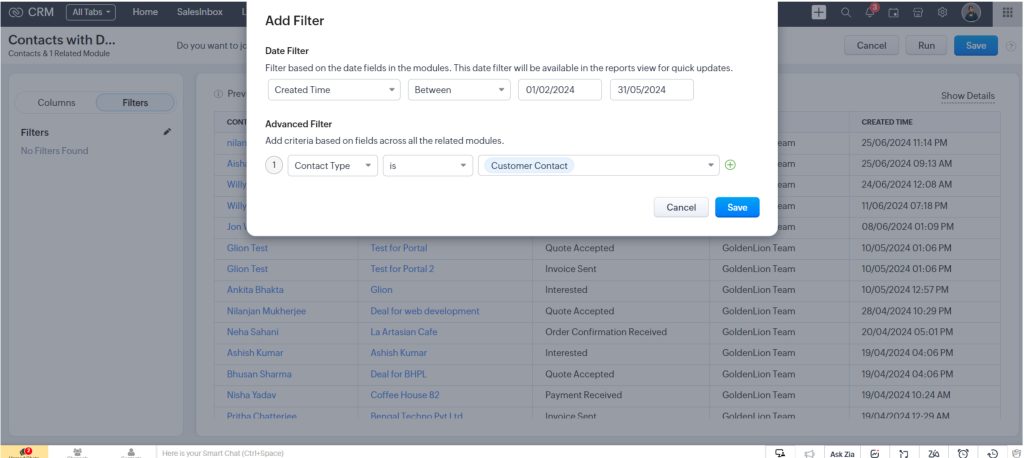In the super-active world of customer relationship management (CRM), the possibility to transform raw data into actionable insights is vital. Zoho CRM is a versatile platform offering various reporting tools designed to meet diverse analytical needs. Whether you are tracking sales performance, monitoring customer interactions, or evaluating marketing efforts, the wide range of Reports in Zoho CRM helps you confidently make data-driven decisions.
In this blog article we will cover all about Reports in Zoho CRM and learn how they can be leveraged to streamline your business and fuel growth.
With a growing business, your data increases and often results in complexities. This data holds information about the various business aspects. Insights from this data are important for the growth of your business, understand current trends, and plan your moves accordingly. That’s Reports in Zoho CRM for you playing a vital role in bringing together all the relevant data as desired to achieve specific goals, such as generating monthly reports, understanding customer behavior, market trends, and much more.
Reports in Zoho CRM offer ample amount of benefits to your businesses. You can make the right decisions keeping in consideration your business performance so far and also helps you understand what steps to take for further success. Here are some key advantages:
Overall, the reporting capabilities in Zoho CRM provide a compact view of business operations, drive efficiency, and support strategic growth.
Creating Reports in Zoho CRM is a seamless and powerful process that enables businesses to gain valuable insights from their data. With Reports in Zoho CRM, users can create various reports, designed to meet different analytical needs. With instinctive steps to select modules, define filters, and customize data views, Zoho CRM’s reporting tools allow you to obtain precise data analysis. Moreover, the ability to add customization, schedule automatic report generation, and share insights across teams ensures that all users can stay informed and updated This helps in making data driven decisions for the business.
Navigate to the Reports Module. In the left panel, you can see all the different types of reports.

Click on the Create Report button icon to create a New Report and also set a name for your Report.
To create a new report we first need to select a Primary Module.

Primary Module in reports refers to the main module from which the report is generated. The data that you want to analyze and report on will be available in this module. When creating reports in Zoho CRM, you first select a primary module as shown below, and then you can pull in related data from other modules as necessary.

Once the Primary Module is selected, choose the related modules.
Here, with a related module, we are building a relationship between the Parent Module and the Child Module.

The parent list shows all modules that are referred to in the lookup fields of the primary module. The child list displays all modules referred to in the related lists of the primary module.
A Parent Module is a module that is linked to the primary module through a lookup field. With this relationship, the primary module can refer to data from the parent module. When creating reports in Zoho CRM, you can include data from these parent modules to provide a more detailed view of related information.
Important Note: For broader information, you can select multiple parent modules.
A Child Module is a module that is linked to the primary module through a related list. This means the primary module can include related records from the child module, allowing you to compile and analyze data in your reports.
Once you have selected your Parent and Child Module click on the Continue Button to move to the next step.

Once the Report is created based on your selection and preferences, it can further be customized by arranging and selecting columns, and adding Filters.


Here once you have applied the filter, you can see the data that matches your filter criteria .
We can further segregate the data of the report in Row Groups or Column Groups.
Lets have a look at the data by segregating them in Row Group.

We can also segregate the data by grouping them into columns.
Grouping them based on the lead sources in a column view.

We also have an Aggregate Column that enables us to perform calculations on row and column groups. Functions such as sum, average, maximum, minimum, and count can be used to display metrics.
Once all of the details are set as desired, Click on the Save button on the right top corner.
Your Contacts with Deals Report is all ready.

Once your report is ready you can further enhance the effectiveness of your report, by incorporating various types of charts to visually represent your data. This includes Pie charts, Bar charts, Funnel charts, and more.


If you are working with Reports in Zoho CRM, here are some important facts that you must know:
In conclusion, Reports in Zoho CRM has robust capabilities that enable businesses to transform raw data into actionable insights. By customizing and obtaining detailed reports, organizations can make informed decisions, optimize processes, and drive growth. Creating these reports is straightforward, allowing businesses to tailor them to their unique requirements with ease. Embrace the power of Zoho CRM reports to unlock the full potential of your data and stay ahead in today’s competitive landscape.
As your business grows, it brings more complex data which is a good thing when it comes to business. But often these data can be challenging when working with reports.